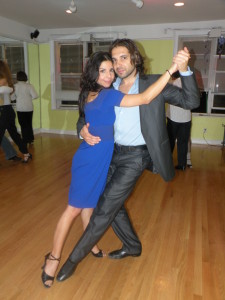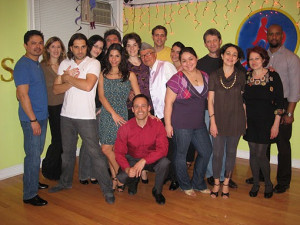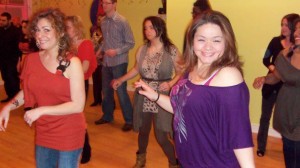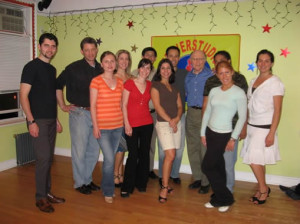Ballroom dance etiquette ten common sense tips.

Carolina and Hugo dancing in Brooklyn at Dance Fever Studios..
1) Dance in the line of dance. Ballroom dancers move around the floor in a counter-clockwise direction. You should be moving in this direction most of the time. This is ballroom dance etiquette 101.
2) When things go wong, apologize. If you bump into someone, or step on someone’s foot, tell them you’re sorry. Don’t just ignore them.
3)Slow dancers should move to the center of the room. So if you are a beginner to ballroom dance, just learning new moves, don’t clog up the main lines of dance. Stay towards the center.
4)Conversation should be off the dance floor. If you’d like to talk, do it off the dance floor.
5)Cross the dance floor around the perimeter. Don’t cut through. I’ve seen people walk across the middle of the ballroom dance floor holding drinks. Not good.
6)Clean up your mess. So, if you are carrying some drinks and you do spill something, clean it up before some dancer slips and gets hurt.
7)Personal hygiene. Make sure you don’t have bad body odor or bad breath. Very important ballroom dance etiquette.
8)Dance at your partner’s ability. If you are an experienced ballroom dance leader dancing with a beginner follower, don’t expect her to do advanced moves. Build the dance. Start with easy stuff. Once you see that she’s with the timing and following easy patters, try advancing to more difficult ones. If she has difficulty doing one turn, don’t lead her in to a double turn.
9)Sneezing and coughing while dancing. This does happen. Always sneeze or cough into the underside of your elbow. Do not sneeze into your hand and then ask her to take that hand for dancing.
10)Don’t chew gum while dancing. This is annoying to your partner. He or she doesn’t want to dance with a cow chewing grass, which is what it feels like. It also doesn’t look elegant. Have you ever seen Fred Astaire chew gum while he dances?






